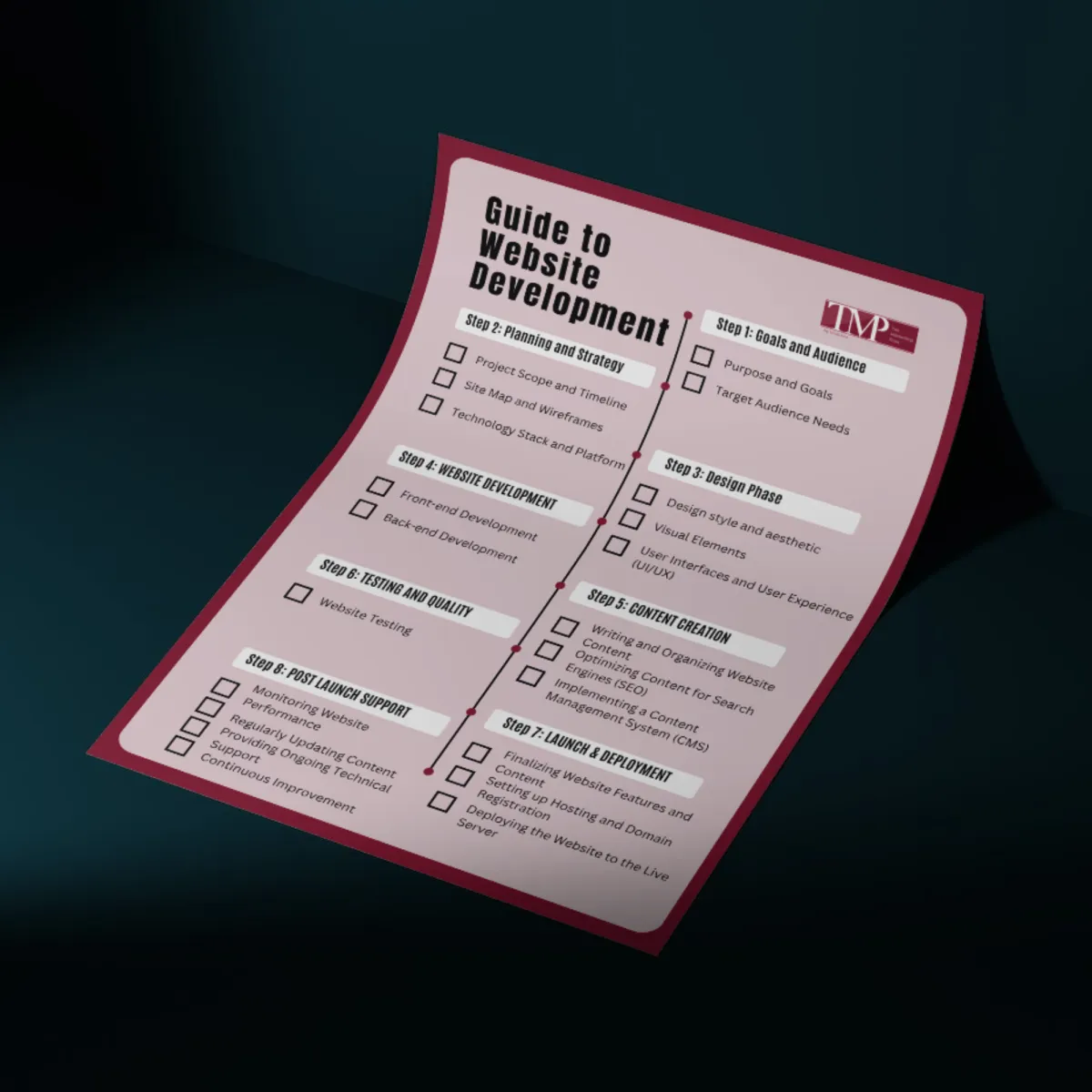Templates
Documents and spreadsheets available for customization to meet the specific needs of your tax advisory practice.

SWOT Analysis
A SWOT analysis is a strategic planning tool used to identify and evaluate an organization's Strengths, Weaknesses, Opportunities, and Threats.

SMART Action Plan
A SMART action plan is a structured framework for setting and achieving specific, measurable, achievable, relevant, and time-bound goals.

Website Development Checklist
A website development checklist is a comprehensive list of tasks and considerations to ensure the successful planning, design, development, testing, and launch of a website.

Blog Post Templates
A blog post template serves as a structured outline that guides the creation of content, ensuring consistency and coherence across posts.

Setting Digital Marketing Strategy
7 marketing strategies designed to take your tax advisory practice to the next level. These strategies will be your roadmap to online success.

Branding Templates
Simplified standards for using the various elements of a brand to ensure that it is presented consistently across all marketing materials and channels.

Digital Marketing Plan Template
A pre-designed framework that helps marketers plan, execute, and monitor digital marketing strategies efficiently.

Buyer Persona Template
Structured outline with characteristics, behaviors, and motivations of a target customer to guide marketing strategies.

Social Media Feed Ads Template
A visually appealing, customizable ad layout designed to engage and convert audiences on social media platforms.

Finding Your Niche Checklist
Finding Your Niche Checklist Template is a comprehensive guide designed to help tax professionals identify and refine their unique niche.

Website Audit Checklist
Evaluate if your website is ready to leverage Google Ads by reviewing checklist. Bridge the gap and bring immediate results.
Other Articles You Might Also Like

5 Steps to Develop an Impressive Marketing Plan + Free Template
Are you a startup company that needs a roadmap to success or an established firm that needs to take a good, hard look at your marketing strategy every year? Then this article is for you!
Without a marketing plan things can easily get messy, as the saying goes “If you fail to plan, you plan to fail.”
A marketing plan serves as a roadmap to guide a company’s marketing efforts and helps ensure that resources are used effectively and efficiently.
By setting clear and achievable objectives in a marketing plan, companies can create targeted strategies that drive growth, enhance customer satisfaction, and achieve long-term success.
Creating an impressive marketing plan needs thorough research, strategic planning, and detailed execution. Here’s a step-by-step guide to help you develop a robust marketing plan, along with a free template you can use.
Step 1: Market Research
In Market research, you need to gather and analyze data about the market in which your business operates. This helps understand market trends, customer needs, and the competitive landscape.
How to Conduct a Market Research:
Define Your Goals: What do you want to learn from your market research?
Collect Data:
Primary Research: Surveys, interviews, focus groups, and observations.
Secondary Research: Industry reports, market analysis, academic journals, and existing data from reputable sources.
Analyze Data: Look for patterns, trends, and insights that can inform your marketing strategy.
Interpret Results: Use the data to make informed decisions about your marketing plan.
Key Areas to Explore:
Market Size: Understand the overall size and growth potential of your market.
Trends: Identify current and emerging trends that could impact your business.
Customer Needs: Determine what your customers need and expect from products or services in your market.
Regulatory Environment: Be aware of any legal or regulatory factors that could affect your business.
A. Target Audience
Your target audience is the specific group of people you aim to reach with your products or services. Defining this helps in creating relevant and effective marketing messages.
How to Define Your Target Audience
Segmentation: Divide the market into segments based on demographics, psychographics, behavior, and geographic location.
Persona Development: Create detailed customer personas that represent your ideal customers. Include information such as age, gender, income, education, interests, and buying behavior.
Needs and Pain Points: Identify the specific needs, desires, and pain points of each persona.
Media Consumption: Understand where and how your target audience consumes media (e.g., social media, blogs, television).
Example of a Buyer Persona

Gather detailed information about your ideal customers and craft a comprehensive profile that represents them. Here is a link to customize your Buyer Persona.
B. Competitor Analysis
Analyzing your competitors helps you understand their strengths and weaknesses, and identify opportunities for differentiation.
How to Perform a Competitor Analysis:
Identify Competitors: List your direct and indirect competitors.
Analyze Competitors: Look at their products, pricing, marketing strategies, strengths, and weaknesses.
Evaluate Market Position: Determine where each competitor stands in the market in terms of market share and brand positioning.
SWOT Analysis for Competitors: Perform a SWOT analysis for key competitors to identify their competitive advantages and potential vulnerabilities.
Key Areas to Analyze:
Product Offerings: Compare features, benefits, and pricing.
Marketing Strategies: Analyze their advertising, promotions, and content marketing.
Customer Reviews: Look at customer feedback to understand what customers like or dislike about their products.
Market Presence: Assess their online presence, social media activity, and engagement.
C. SWOT Analysis
A SWOT analysis helps you identify your business’s internal strengths and weaknesses, as well as external opportunities and threats.
Steps for Conducting a SWOT Analysis:
Strengths: Identify internal attributes that give your business an advantage over competitors.
Weaknesses: Identify internal attributes that place your business at a disadvantage.
Opportunities: Identify external factors that your business could exploit to its advantage.
Threats: Identify external factors that could cause trouble for your business.
We have prepared free resources to guide you in successfully creating your SWOT analysis:
Step 2: Setting Marketing Goals
Marketing goals are specific objectives that align with your overall business goals. They guide your marketing strategy and provide a framework for measuring success.
Using the SMART criteria ensures that your goals are clear and achievable. Balancing long-term and short-term goals helps maintain focus on immediate needs while working towards future objectives.
A. SMART Goals
SMART goals are specific, measurable, achievable, relevant, and time-bound objectives that provide a framework for setting clear and actionable goals.
The SMART criteria help ensure that goals are well-defined, realistic, and aligned with overall business objectives. Here's what each component of SMART goals entails:
Specific: Clearly define what you want to achieve.
Measurable: Comprises criteria to track progress and success.
Achievable: Set realistic goals that are within your capabilities.
Relevant: Ensure the goals align with your overall business objectives.
Time-bound: Set a deadline for achieving the goals.
Example of SMART Goals: Download here
Customize your SMART Goal for free
B. Long-term and Short-term Goals
Long-term goals focus on the bigger picture and are typically set for one year or more. They help guide the strategic direction of your marketing efforts.
Examples of Long-Term Goals
Brand Recognition: Establish your brand as a leader in your industry within two years.
Market Expansion: Enter and establish a presence in three new markets over the next five years.
Customer Loyalty: Increase customer retention rate by 30% over the next three years.
Short-term goals are more immediate and are typically set for a period of a few months to a year. They are often steps that lead to achieving long-term goals.
Examples of Short-Term Goals
Content Marketing: Publish two blog posts per week for the next six months.
Email Marketing: Grow your email subscriber list by 15% in the next quarter.
Sales Promotion: Run a seasonal sales campaign that increases sales by 10% over the next three months.
Step 3: Strategy and Tactics
Creating a comprehensive digital marketing plan involves defining an effective marketing strategy, branding, and marketing mix (Product, Price, Place, Promotion) or 4P’s.
Strategy is your overall plan to achieve your marketing goals and tactics are the specific actions you take to execute your strategy.
A. Positioning and Branding
Positioning is how you want your brand to be perceived in the minds of your target audience and branding pertains to creating a unique image and identity for your brand.
How to Develop Positioning and Branding
Define Your Unique Selling Proposition (USP): Identify what sets your brand apart from competitors.
Create a Brand Voice and Personality: Decide how your brand will communicate and interact with the audience.
Develop Visual Identity: Design a logo, color scheme, typography, and other visual elements that represent your brand.
Craft Your Brand Story: Create a narrative that explains who you are, what you do, and why you do it.
Consistent Messaging: Ensure all marketing materials reflect your brand's positioning and values.
We’ve curated simplified standards for using the various elements of a brand to ensure that it is presented consistently across all marketing materials and channels.
B. Marketing Mix (Product, Price, Place, Promotion)

The marketing mix, often referred to as the 4Ps, is a foundational model in marketing that outlines the key elements involved in marketing a product or service. The 4Ps are:
Product: This encompasses the goods or services offered by a business to meet the needs and desires of consumers. Key considerations include:
Product design and features
Quality
Branding
Packaging
Product lifecycle
Warranties and guarantees
Price: This element determines the appropriate pricing strategy for the product or service. Factors to consider are:
Cost of production
Competitor pricing
Market demand
Perceived value
Pricing strategies (e.g., penetration, skimming, competitive pricing)
Discounts and financing options
Place: Also known as distribution, this refers to how the product is delivered to the customer. Considerations contain:
Distribution channels (e.g., online, retail stores, wholesalers)
Market coverage (intensive, selective, or exclusive distribution)
Inventory management
Transportation and logistics
Location and convenience for the target market
Promotion: This involves the various strategies used to communicate the benefits and value of the product to the target market. Key aspects include:
Advertising (e.g., TV, radio, online, print)
Sales promotions (e.g., discounts, coupons, contests)
Public relations (e.g., press releases, sponsorships)
Personal selling (e.g., sales teams, customer service)
Digital marketing (e.g., social media, email marketing, content marketing)
C. Digital Marketing Strategy
A digital marketing strategy is a plan for using digital channels and technologies to achieve specific marketing goals.
Download the 7 marketing strategies designed to take your business to the next level. These strategies will be your roadmap to online success.
Step 4: Implementation Plan
A comprehensive marketing plan consists of several key elements such as marketing channels, budget allocation, and timeline.
An implementation plan outlines the steps and actions necessary to achieve the marketing objectives. It includes:
Objectives: Clear and measurable goals.
Strategies: The approaches to achieve these objectives.
Tactics: Specific actions and activities to implement the strategies.
Roles and Responsibilities: Assigning tasks to team members.
Resources: Tools, platforms, and materials needed.
Performance Metrics: KPIs to measure success.
A. Marketing Channels
Marketing channels are the platforms or mediums through which the marketing messages will be delivered. Here are the common channels:
Social Media: Facebook, Instagram, Twitter, LinkedIn, etc.
Email Marketing: Newsletters, promotional emails.
SEO and SEM: Search engine optimization and marketing.
Content Marketing: Blogs, articles, videos, podcasts.
PPC Advertising: Google Ads, social media ads.
Influencer Marketing: Collaborations with influencers.
B. Budget Allocation
Budget allocation relates to distributing the marketing budget across different channels and activities. Here are some helpful steps to allocate the budget:
Setting a Total Budget: Determining the overall amount available for marketing.
Prioritizing Channels: Based on past performance and expected ROI.
Allocating Funds: Distributing the budget across chosen channels and activities.
Contingency Fund: Setting aside a portion for unexpected expenses.
C. Timeline
A timeline outlines the schedule for executing the marketing plan. It includes:
Milestones: Key dates and deadlines.
Phases: Breaking down the plan into stages (e.g., planning, execution, evaluation).
Tasks and Activities: Specific tasks to be completed within each phase.
Dependencies: Tasks that depend on the completion of others.
Review Points: Regular intervals to assess progress and make adjustments.
Step 5: Evaluation and Control
A. Key Performance Indicators (KPIs)
KPIs are specific, measurable values that help you track the effectiveness of your marketing strategies.
They should align with your business objectives and can cover metrics like customer acquisition cost, conversion rate, and return on investment (ROI).
What Metrics to Track?
Website Traffic such as unique visitors, page views, bounce rate, and average session duration
Conversion Metrics, cost per conversion, or conversion funnel drop-off rates
Email Marketing Metrics such as open rate, click-through rate, conversion rate, and bounce rate
Social Media Metrics, including engagement, reach, and follower growth rate
SEO Metrics such as organic traffic, keyword rankings, or backlink profile
Paid Advertising Metrics such as CPC, conversion rate, and return on ad spend
B. Metrics for Success

Metrics for Success are the specific data points and measurements you use to evaluate how well your marketing plan is performing.
Metrics might include website traffic, lead generation, social media engagement, and sales growth.
Examples of Metrics for Success:
Click-Through Rate (CTR): Percentage of people who click on a link compared to those who view the ad or email.
Bounce Rate: Percentage of visitors who leave the site after viewing only one page.
Engagement Rate: Measures interactions (likes, shares, comments) on social media.
Email Open Rate: Percentage of recipients who open your email campaigns.
Cost Per Click (CPC): The amount paid for each click in a pay-per-click advertising campaign.
C. Monitoring and Adjusting the Plan
This involves regularly reviewing your KPIs and metrics to see if you’re meeting your goals.
If your performance isn’t meeting expectations, you’ll need to adjust your strategies. This could be tweaking your campaigns, reallocating your budget, or experimenting with new tactics.
Effective monitoring and adjustment involve:
Regular Reviews: Schedule regular intervals (e.g., weekly, monthly) to review performance data.
Analytics Tools: Utilize tools like Google Analytics, CRM systems, and marketing dashboards to track KPIs and metrics.
Performance Analysis: Compare current performance against benchmarks and historical data.
Identify Trends: Look for patterns in the data that indicate success or areas for improvement.
Adjust Strategies: Modify marketing tactics based on insights gained from data analysis (e.g., reallocate budget, tweak messaging).
Conclusion
A well-organized marketing strategy serves to not only outline the strategic course but also to offer practical steps for implementation.
It contains market analysis, goal establishment, strategic planning, and performance assessment within a unified structure.
Understanding your target market, defining your audience, analyzing competitors, and setting clear objectives enable the creation of targeted strategies that are aligned with your business objectives.
Next Steps
Conduct Market Research: Start by gathering data on your market, target audience, and competitors. Use this information to inform your strategy and identify opportunities.
Set SMART Goals: Define specific, measurable, achievable, relevant, and time-bound goals that align with your business objectives. Establish both long-term and short-term goals.
Develop Your Strategy: Create a strategic plan that includes positioning, branding, and the marketing mix (Product, Price, Place, Promotion). Outline your digital marketing strategy and choose the right channels for your audience.
Implement Your Plan: Create an implementation plan that details objectives, strategies, tactics, roles, resources, and performance metrics. Allocate your budget, select marketing channels, and set a timeline for execution.
Monitor and Adjust: Regularly review your KPIs and metrics to track performance. Use analytics tools to assess progress and make data-driven adjustments to your strategies as needed.
Utilize Resources: Take advantage of free templates and tools available for market research, SWOT analysis, SMART goals, and more to streamline your planning process.
By adhering to these steps, you’ll be well on your way to executing a successful marketing plan that drives your business forward.
Remember, flexibility and ongoing evaluation are key to adapting to market changes and achieving sustained success.
Free Marketing Plan Template

Do you want to skip the tutorial? Create your marketing plan right away with Tax Marketing Pros. Utilize a ready-made marketing plan template, and download it as a PDF.
Here's a free pre-designed marketing plan template you can use to get started:
